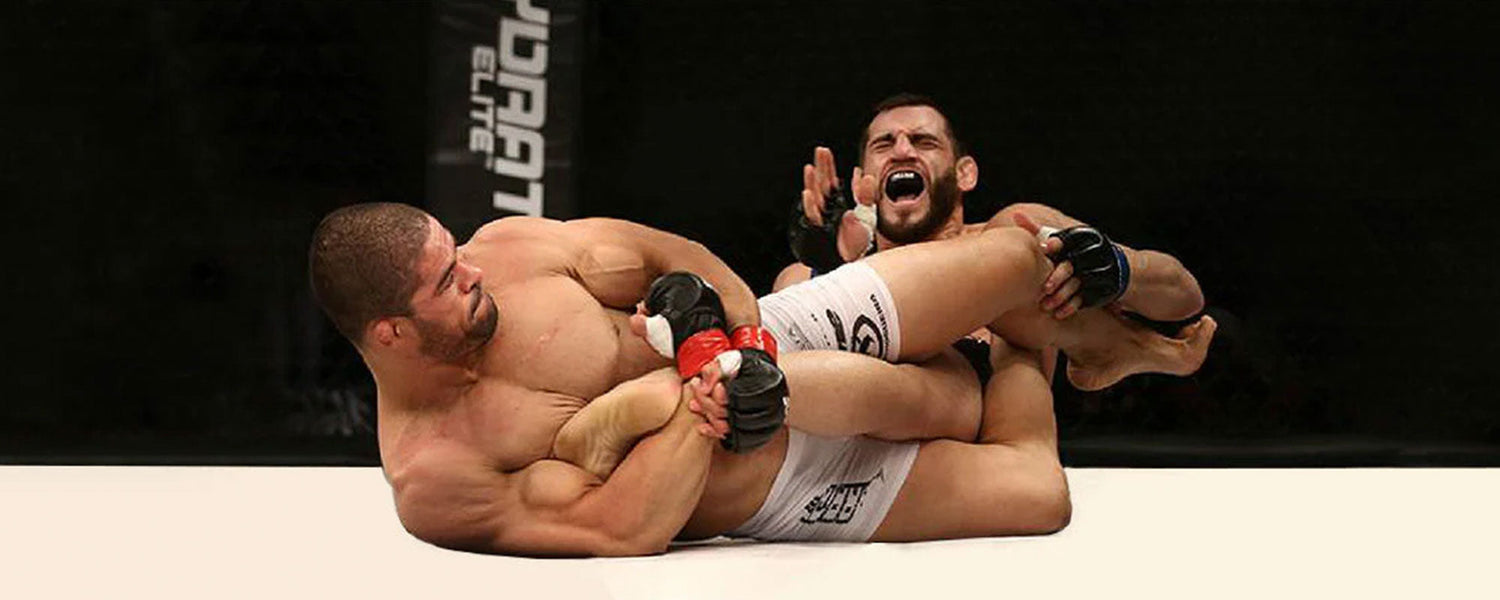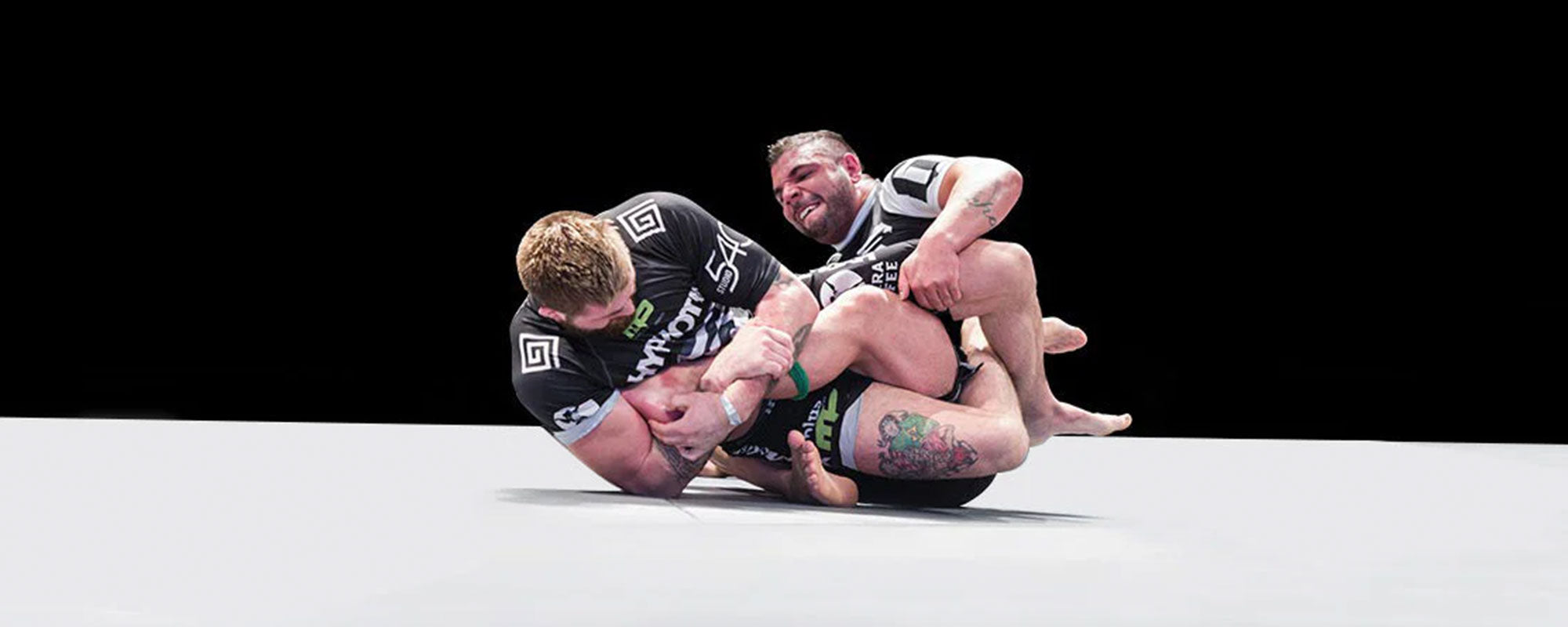Table of content
Heel hooks were considered a forbidden technique in jiu-jitsu for years but now has become one of the most popular techniques to learn.
Many coaches refused to teach heel hooks in the past since they were dangerous and banned in most competitions. But thanks to professional grappling competitions like ADCC and EBI, they are gaining popularity again.
If you’re also a BJJ fanatic trying to excel in your game with this deadly submission, you came to the right place! Discover everything about the heel hook in this read, including its origin, how it works, and different ways to use it on the mats.
1. What is a Heel Hook?
The heel hook is a powerful leg-based submission used in Jiu-Jitsu, martial arts, and Sambo, that forces an opponent to tap out. It mainly attacks the knee joint but also has the potential to severely damage the ankle.
The heel hook can affect multiple joints in the leg and is considered one of the most dangerous leg locks due to a high risk of injury. That’s why it is illegal to perform in many grappling competitions, even today, except in advanced Brazilian Jiu-Jitsu and Sambo.
The heel hook relies on the rotational force of the knee joint, unlike straight foot locks which hyperextend the joint beyond its normal range, forcing the knee to completely twist from its normal line of motion.
The heel hook can be used to improve one’s position, to pin the opponent, and also in self-defense a pain compliance technique.
1.1. How does it work?
The heel hook aims at twisting the foot either laterally or medially by using the heel. There are many variations of the heel hook, the most basic involves placing your legs around the opponent’s legs and holding his foot in the armpit on the same side.
The legs are used to control the opponent’s body movements while twisting the foot. The whole body is used to generate a twisting motion, which creates severe torque on the ankle. This technique exerts immense pressure on the ankle, hence, damaging the knee and the foot.
2. The Origin of Heel Hook
The heel hook submission originated 1000 years ago, just like most of our modern-day martial arts techniques.
Ancient Greece had one of the first types of grappling where the heel hook was portrayedin the culture’s artwork. The popular Pankration and its technological advancements were adopted by Roman culture, which absorbed many features of Ancient Greek social life.
Many Ancient Egypt Wrestling drawings illustrated a range of leg attacks, including the heel hook which predates Ancient Greece.
3. The History of Heel Hook in BJJ
Although people have been practicing Heel Hook for centuries, its history in BJJ dates back to the 1960s.
There is a famous myth that “Ivan Gomes,” the renowned 1960s grappler, created the heel hook submission in BJJ. However, this claim was only supported by Carlson Gracie’s statement in an interview in which he said,
“The heel hook we use today was created by Ivan”
In 1990 after the demise of Ivan Gomes, Jose Gomes, his younger brother, stated that:
“The heel hook existed before us. It came through Japanese that landed here in Northeast Brazil. Our coach learned it from Takeo Yano, who was a great fighter.”
Ivan Gomes was probably the first fighter to bring attention to heel hooks in Brazil. However, Takeo Yano was the one who mainly disseminated BJJ and heel hook in the northeast region of Brazil in the early 20th century.
4. Use of Heel hook in Jiu Jitsu Sport
For many years, leg locks like heel hooks were considered a cheap way to win in Brazilian Jiu-Jitsu.
In the 1970s, when Jiu-Jitsu started taking the form of a sport, many top instructors in Rio de Janeiro gathered together to make the rules for BJJ Sport. They devised a point system as well as a restriction book, stating which moves were banned, including the heel hook.
These rules imposed a stigma on the use of heel hooks and for years, this technique was frowned upon in Brazilian Jiu-Jitsu. It was believed that a person would only use this technique if he was not smart enough to guard properly.
In the modern era, mixed martial arts, such as Sambo and Submission Wrestling, played a major role in revolutionizing the heel hook.
In the late 1990s, heel hooks slowly made their way back to the sport once Jiu-Jitsuopened its doors to foreign competitors. Dean Lister and John Danaher were among the first grapplers who popularized the use of heel hooks in BJJ.
Later on, heel hooks became prominent when IBJJF allowed their use in No-Gi competitions (for brown and black belts only) promoted by ADCC, NAGA, and many others. In 2021, the revival of the platform “Submission Only” pushed the concept of heel hook even further.
5. How to perform a basic heel hook?
The best way to perform a basic heel hook is to first form the position, then lock your legs around the opponent’s legs, and then switch to the heel. For your convenience, the step by step instruction is given below:
- Step 1: Control the Leg
The key to performing a heel hook is to control the opponent’s leg. If you fail to establish control of the leg before twisting the heel, you won’t be able to get the submission.
There are many ways to control your competitor’s leg, but they all follow the same principle i.e. “to control the leg above the knee.” Moreover, your hips must align with your opponent while doing so.
- Step 2: Bend the leg
The next step is to bend your competitor’s leg at an angle where you can perform the heel hook.
- Step 3: Twist the Heel
Go for his/her heel after gaining leg control.Turn your body towards his/her heel, use the blade of your forearm to hook it so that it’s tight, and apply pressure by running towards your back shoulder.
6. Types of Heel Hook
There are two main variations of heel hook in Brazilian Jiu Jitsu: inside and outside heel hook. They mainly differ in the leg entanglement used to secure the opponent’s legs.
It is important to have solid control of your opponent’s knee line for each type of heel hook. This is achieved by pinching your knees together around your competitor’s thigh above the knee level.
Such control ensures that your rotational force is being applied directly to the knee, without allowing his/her hips to move and absorb the force.
6.1. Outside Heel Hook
Outside heel hook can be performed with traditional Asha Garami leg entanglements. The term outside means that your opponent’s heels are rotated away from the body.
- How to perform?
In this case, instead of hooking over your opponent’s ankle, you need to weave your elbow crook behind your opponent’s heel while controlling his toes in your armpit on the same side.
Once you have locked this position, bridging into your opponent’s knees will produce an enormous rotational force on the knee, along with a deadly finish.
6.2. Inside Heel Hook
The inside heel hook is a similar move performed by holding your competitor’s foot in the opposite armpit and twisting it laterally.
Also known as the reverse or inverted heel hook, this variation is considered the most deadly of all heel hooks as it allows the attacker to isolate movement in the tibiofemoral joint, unlike the outside heel hook.
The term inside means that your opponent’s heels are rotated towards his/her body.
- How to Perform?
For the inside heel hook, you need to control your opponent’s heel with your elbow pit and pinch down on his/her toes with your lats and upper arm.
Once you have locked this position, gentle bridging with your hips will apply the rotational force directly to your competitor’s knee, rotating the heels inwards towards the body.
7. Primary Heel Hook Positions
Assuming a good position is as important as performing the heel hook itself. Coaches often go by the saying, “position before submission.”
There are many types of leg entanglements, but the primary relevant positions and their corresponding heel hooks are given below:
7.1 Ashi Garami
Ashi Garami is the most important and basic leg lock position which attacks the opponent’s legs by using joint locks. In this position, the aim is to pin the opponent by extending his/her leg or foot.
Ashi Garami position is ideal for performing an outside heel hook when your opponent is attacking and has his/her heels exposed.
7.2 Leg Triangle or Honey Hole (4/11)
The honey hole, 4/11, and leg triangle are all different variations of the same leg entanglement. In this case, your front leg is placed over your opponent’s leg and your back leg is kept behind your opponent’s thigh, isolating the target leg.
These positions are ideal for performing the inside heel hook.
7.3 50/50
50/50 is a position in which your inside legs are intertwined with your opponent’s inside legs, putting you both in the same position. Hence, you are both vulnerable to the same attack.
8. How dangerous are Heel Hooks?
The heel hook is arguably the most dangerous submission hold as it can isolate the femur and rotate the tibia beyond its normal range of motion. Moreover, it directly attacks the ligaments, which have fewer sensory receptors compared to other body structures.
This twisting technique not only damages the ligaments in the knee but also ligaments in the foot, causing sudden dorsal pain in the knee, pelvis, and thighs.
If too much pressure is applied, it can tear the MCL, ACL, and LCL ligaments in the knee, destroying almost everything below the hip.
(MCL: Medial Collateral Ligament: connects thigh bone to shin bone on the inside of the knee, ACL: Anterior Cruciate Ligament: connects the femur to the tibia, and LCL: Lateral Collateral Ligament: connects the fibula to thigh bone).
9. When to add Heel Hooks in your game?
The heel hook is an advanced move that is mostly performed by only experienced grapplers with a comprehensive understanding of the technique.
However, all grapplers should have a basic understanding of leg attacks including the heel hook, regardless of the belt color. Many gyms teach leg attacks after a student achieves a specific proficiency level for safety reasons. Therefore, it is advisable to add this technique to your repertoire after completing the proper training.
Whether you’re a gi or no-gi player, the proper use of this submission will surely help you to immobilize your opponent and cause him enormous pain.
10. Tips for performing Heel Hook
While performing the heel hook, it is imperative to focus on your technique by keeping in mind the following tips.
- Leave no space open as it can give your opponent a chance to escape.
- Use your wrist’s blade to make the heel hook as tight as possible.
- Keep your hips aligned with your opponent’s to ensure that there is no space available for escape.
- Bend your opponent’s leg to make an angle of about 90 degrees with your hips aligned.
- Turn into your opponent’s heel to take a hold of their foot before performing the heel hook.
- Control the top of your opponent’s foot with your armpit or triceps before getting the grip on their heel.
- Control your opponent’s leg above the knee to ensure a heel hook.
Photo Credit: @mixedmartialarts












Leave a comment
This site is protected by hCaptcha and the hCaptcha Privacy Policy and Terms of Service apply.